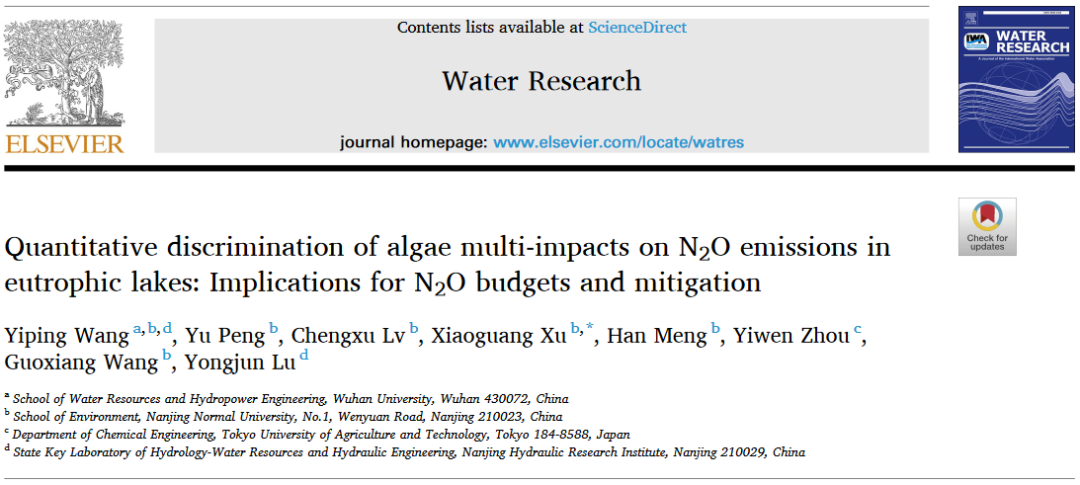【欢迎您关注--农业环境科学】


南京师范大学环境学院许晓光团队探究了富营养化的太湖中藻类动态变化对N2O排放时空变化的相对贡献。相关成果发表于Water Research(IF=13.400)。
阅读论文全文请点击文末阅读原文。
文章链接:
https://doi.org/10.1016/j.watres.2023.119857
•Dissolved N2O of algae accumulation areas showed supersaturation with strong release potential.
•Eutrophic lake was an N2O emission source with the highest flux in algae decay areas.
•N2O produced via microbial effects and water-gas exchanges were affected by N2O reduction.
•Algae decomposition increased the N2O proportion produced via denitrification.
•Excessive algae accumulation on the water surface reduced its facilitating effect on N2O emissions.
It is generally accepted that eutrophic lakes significantly contribute to nitrous oxide (N2O) emissions. However, how these emissions are affected by the formation, disappearance, and mechanisms of algal blooms in these lakes has not been systematically investigated. This study examined and determined the relative contribution of spatiotemporal N2O production pathways in hypereutrophic Lake Taihu. Synchronously, the multi-impacts of algae on N2O production and release potential were measured in the field and in microcosms using isotope ratios of oxygen (δ18O) and bulk nitrogen (δ15N) to N2O and to intramolecular 15N site preference (SP). Results showed that N2O production in Lake Taihu was derived from microbial effects (nitrification and incomplete denitrification) and water air exchanges. N2O production was also affected by the N2O reduction process. The mean dissolved N2O concentrations in the water column during the pre-outbreak, outbreak, and decay stages of algae accumulation were almost the same (0.05 μmol·L–1), which was 2–10 times higher than in lake areas algae was not accumulating. However, except for the central lake area, all surveyed areas (with and without accumulated algae) displayed strong release potential and acted as the emission source because of dissolved N2O supersaturation in the water column. The mean N2O release fluxes during the pre-outbreak, outbreak, and decay stages of algae accumulation areas were 17.95, 26.36, and 79.32 μmol·m–2·d–1, respectively, which were 2.0–7.5 times higher than the values in the non-algae accumulation areas. In addition, the decay and decomposition of algae released large amounts of nutrients and changed the physiochemical properties of the water column. Additionally, the increased algae biomass promoted N2O release and improved the proportion of N2O produced via denitrification process to being 9.8–20.4% microbial-derived N2O. This proportion became higher when the N2O consumption during denitrification was considered as evidenced by isotopic data. However, when the algae biomass was excessive in hypereutrophic state, the algae decomposition also consumed a large amount of oxygen, thus limiting the N2O production due to complete denitrification as well as due to the limited substrate supply of nitrate by nitrification in hypoxic or anoxic conditions. Further, the excessive algae accumulation on the water surface reduced N2O release fluxes via hindering the migration of the dissolved N2O into the atmosphere. These findings provide a new perspective and understanding for accurately evaluating N2O release fluxes driven by algae processes in eutrophic lakes.

人们普遍认为富营养化湖泊的氧化亚氮(N2O)排放会显著增加。然而,湖泊中水华的形成、消失和机制如何影响N2O排放,还没有得到系统的研究。本研究探究了富营养化的太湖中不同途径对N2O排放时空变化的相对贡献。同时,在田间和微环境中利用氧(δ18O)和氮(δ15N)与N2O的同位素比值以及分子内15N位点偏好(SP),测定了藻类对N2O产生和释放潜力的多重影响。结果表明,太湖N2O的产生主要来源于微生物作用(硝化和不完全反硝化)和水气交换。N2O的产生也受到其还原过程的影响。水体中的溶解N2O浓度在藻类暴发前、暴发中和衰退阶段基本相同(0.05 μmol•L-1),比无藻类暴发的区域高2~10倍。但由于水体中溶解态N2O过饱和,除中心湖区外,所有调查区域(有藻和无藻)均表现出较强的释放潜力,可能成为N2O排放源。藻类暴发区N2O释放通量在暴发前、暴发中和衰退阶段的平均值分别为17.95、26.36 μmol•m-2•d-1和79.32 μmol•m-2•d-1,是无藻类暴发区N2O释放通量的2.0~7.5倍。藻类的腐烂和分解释放了大量的营养物质,改变了水体的物理化学性质。此外,藻类生物量的增加促进了N2O的释放,提高了通过反硝化过程产生N2O的比例,达到了9.8%~20.4%。同位素数据表明,若考虑反硝化过程中N2O的消耗,这一比例将会更高。但是,当藻类生物量在高富营养化状态下过高时,其分解也消耗大量氧气,由于完全反硝化以及在低氧或缺氧条件下硝化对硝酸盐的底物供应有限,从而限制了N2O的产生。此外,过量的藻类聚集在水面上,也会通过阻碍溶解的N2O迁移到大气中而降低N2O的释放通量。这些发现能够为准确评估富营养化湖泊中藻类动态驱动的N2O释放通量提供新的视角和认识。
责任编辑:宋潇
校对和审核:张阳 王农



